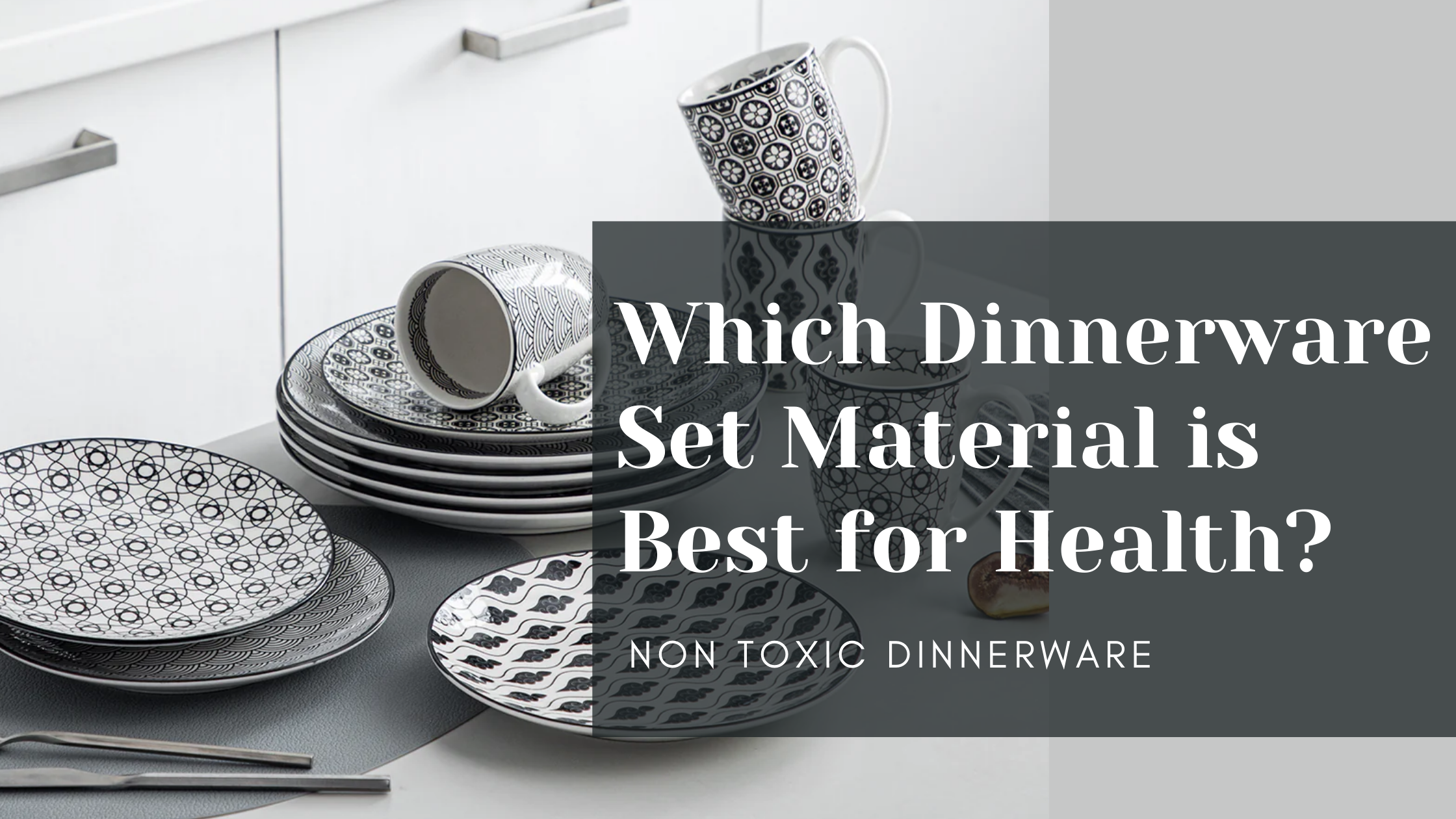When it comes to choosing dinnerware for your home, the material you select matters. It's not just about aesthetics or durability; the material your plates, bowls, and cups are made from can directly affect your health. While many of us may not think about the possible dangers of toxic chemicals in our dinnerware, it's essential to consider which materials are the safest for daily use.
In this post, we will explore the most common dinnerware materials, their benefits, and their potential health risks. We’ll also help you choose the best option for you and your family.
1. Ceramic Dinnerware
Ceramic dinnerware is extremely popular due to its beautiful designs and wide availability. There are a few types of ceramic, including earthenware, stoneware, and porcelain. These differ in the temperatures used during the firing process, which impacts their durability.
-
Benefits: Ceramic dinnerware is generally safe for daily use. High-quality ceramic that's been properly glazed and fired in a kiln at high temperatures is typically non-toxic and food-safe. It's durable and can withstand regular use and cleaning. The glaze, if done properly, prevents food from interacting with the material underneath.
-
Health Risks: The key concern with ceramic dinnerware is lead or cadmium exposure. Some ceramics, especially those with bright glazes or intricate decorations, can contain these toxic metals. When the ceramic is not fired at high enough temperatures or the glaze is improperly applied, the lead or cadmium can leach into food and drinks.
-
Conclusion: If you opt for ceramic dinnerware, make sure it's labeled as lead-free or food-safe. Avoid using antique or handmade items that may not meet modern safety standards.
2. Glass Dinnerware
Glass is another popular choice for dinnerware. It’s transparent, easy to clean, and does not absorb stains or odors. Glassware can range from everyday use to elegant sets for special occasions.
-
Benefits: Glass is non-porous, which means it won’t absorb food odors or flavors, and it’s generally free from harmful chemicals. Most glass dinnerware is made from tempered glass, which is treated to make it stronger and more resistant to breakage. Glass is also dishwasher-safe and microwavable.
-
Health Risks: The biggest advantage of glass dinnerware is that it's usually free of toxic substances like lead, BPA, or cadmium. However, not all glass is created equal. Some decorative glassware or older pieces may contain harmful metals. It’s important to ensure that the glass you’re using is food-safe and free from contaminants.
-
Conclusion: Glass dinnerware is a healthy and safe option for everyday use. Just make sure to choose high-quality, tempered glass that’s labeled as food-safe.
3. Stainless Steel Dinnerware
Stainless steel is a durable, non-reactive material used for a variety of cookware and dinnerware products. You’ll often find stainless steel bowls, cups, and even plates.
-
Benefits: Stainless steel is non-toxic, resistant to corrosion, and won’t leach harmful chemicals into your food. It’s also durable and long-lasting. Stainless steel is easy to clean, resistant to bacteria, and lightweight, making it great for everyday use or even outdoor meals.
-
Health Risks: Stainless steel is one of the safest materials for dinnerware, but some low-quality versions may contain nickel or other metals that can cause allergic reactions. It’s important to ensure that the dinnerware you purchase is made from food-grade stainless steel (look for 18/8 or 18/10 stainless steel).
-
Conclusion: Stainless steel is a great choice for those seeking a long-lasting, non-toxic material for their dinnerware.
4. Melamine Dinnerware
Melamine is a type of hard plastic that’s used to create lightweight, durable dinnerware. It’s popular for casual dining, especially for children or outdoor use.
-
Benefits: Melamine is shatterproof, which makes it ideal for families with young children. It comes in a variety of colors and designs, is lightweight, and won’t break when dropped.
-
Health Risks: While melamine is durable, it poses some health risks. When heated (in the microwave or with very hot food), melamine can leach into food. This can be harmful over time, especially if the dinnerware contains formaldehyde or other toxic chemicals.
-
Conclusion: Melamine should be used with caution. Avoid using it with hot foods or in the microwave. If you’re concerned about chemical exposure, it’s best to use other materials for your primary dinnerware set.
5. Bamboo Dinnerware
Bamboo is a relatively new material used for dinnerware. It’s eco-friendly and biodegradable, making it a great choice for those who want sustainable options in their kitchen.
-
Benefits: Bamboo dinnerware is lightweight, biodegradable, and made from renewable resources. Many bamboo dinnerware sets are made without harmful chemicals like BPA or phthalates, making them safe for everyday use. Bamboo is also durable and aesthetically pleasing.
-
Health Risks: Some bamboo dinnerware products are mixed with melamine to make them stronger and more heat-resistant. While bamboo itself is non-toxic, when melamine is added, the risks mentioned earlier come into play. It’s important to check the labeling on bamboo dinnerware to ensure that it’s free from added chemicals.
-
Conclusion: Bamboo dinnerware is a good eco-friendly option, but be cautious of products that include melamine or other plastic additives.
6. Bone China and Porcelain Dinnerware
Bone china and porcelain are both types of ceramic, but they are fired at higher temperatures, making them more durable and chip-resistant. Bone china contains bone ash, which gives it its signature whiteness and lightness.
-
Benefits: Both bone china and porcelain are non-toxic and do not absorb bacteria or odors. They are durable and can last for years when properly cared for. They are also dishwasher- and microwave-safe, making them easy to use.
-
Health Risks: Just like other ceramics, the main concern with bone china and porcelain is the potential for lead or cadmium in the glaze. However, most modern bone china and porcelain made by reputable manufacturers are lead-free.
-
Conclusion: Bone china and porcelain are elegant, safe options for dinnerware as long as they are labeled as lead-free or food-safe.
7. Clay Earthenware
Earthenware is another type of ceramic, but it’s fired at lower temperatures, making it more porous and less durable than porcelain or stoneware.
-
Benefits: Earthenware can have a rustic, handmade charm, and some people love the way it looks on a dinner table. It’s typically affordable and can come in a variety of styles.
-
Health Risks: Due to its porous nature, earthenware can absorb liquids and bacteria, making it less hygienic than other materials. Like other ceramics, there’s also a risk of lead contamination in the glaze.
-
Conclusion: Earthenware is best used for decorative purposes rather than everyday dining, as it poses some health risks due to its porousness and potential for lead contamination.
Final Thoughts: The Safest Dinnerware for Health
When choosing dinnerware for health, the safest materials are glass, high-quality ceramic, stainless steel, and certain types of bamboo. These materials are generally free from harmful chemicals, durable, and non-toxic.
For everyday use, glass and stainless steel are the top choices due to their durability, safety, and ease of cleaning. Ceramic and bamboo are also good options if they are labeled as food-safe and lead-free. Avoid using melamine for hot foods or in the microwave to prevent potential chemical leaching.





